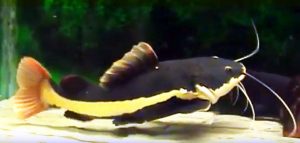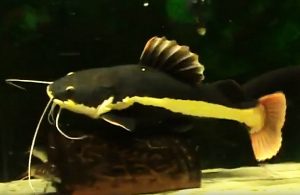The South American Redtail Catfish (Phractocephalus hemioliopterus) known to tropical fish keeping enthusiasts simply as the “Red Tail Cat“, Cajaro, or Pirarara is native to the Amazon, Essequibo, and Orinoco river basins in South America. It is collected as juveniles for the aquarium trade from the larger rivers, streams, lakes, and flooded forest throughout Bolivia, Brazil, Columbia, Ecuador, Guyana, and Venezuela.
The Redtail Catfish is a colorful omnivorous species that in their natural habitat can grow to almost 6 feet in length.
Because of their enormous size, the Redtail Catfish is considered a game fish in the Amazon, and has been introduced into many areas of Thailand as a sport fish. They are also popular in South American exhibits where they are housed with other larger species such as Black Pacu, Arapaima, and other large catfish species.
Redtail Catfish have a brown to black colored back, yellow to white colored sides, and red to reddish/orange tipped dorsal, adipose, and caudal fins. The head and upper part of the body is dotted with myriads of darker black to brown spots. They possess a long pair of barbels on the upper jaw, and two smaller pairs of barbels on the lower jaw.
In the United States, juvenile Redtail Catfish are often sold to tropical fish keeping enthusiasts who quickly discover how fast they can outgrow their aquariums.
If you decide to purchase a juvenile Redtail Catfish, you will need a huge aquarium of at least 250 gallons, that will need to eventually be replaced by one of at least 2,000 gallon capacity.
Juvenile Redtail Catfish can be housed in a large planted single species tank with a sandy or fine pebble gravel substrate, some driftwood or bogwood, some large smooth river rocks, and some floating plants to diffuse overhead lighting. They prefer low light conditions and should be kept in a dimly lit aquarium or a tank with floating plants like Water Hyacinth.
A large, efficient wet/dry type biological filtration system is highly recommended to deal with the huge amounts of waste produced by adult Redtail Catfish. This type filtration system, located outside of the tank, is less likely to be destroyed by larger fish. It’s a good idea to keep the heater in the outside sump as well.
If housed as juveniles in a community environment, remember that even a small Redtail catfish will swallow almost anything it can get into it’s mouth, including objects in the tank. They are peaceful to other fish of like size, but territorial towards conspecifics and other large Pimelodids.
Good tank mates for a large exhibit would be Pacu, Doradids like Oxydoras niger, large characins, and cyprinids.
Through the use of hormones, Redtail Catfish have been hybridized with other species like the Tiger Shovelnose catfish resulting in “Tiger Redtail Catfish” which occasionally are seen in the aquarium trade, however, to date they have not been bred in an aquarium environment.
In their natural habitat, Phractocephalus hemioliopterus are opportunistic predators that feed on live and dead fish, worms, crabs, snails, shrimp, and fruits that fall into the water column.
In an aquarium environment, they will eat almost anything you put into their tank but do best as juveniles on shrimp pellets, bottom feeder wafers, prawns, worms, krill, mussels, etc. Feed only once or twice a week.
Larger specimens should be fed live or fresh dead white fish, shrimp, crabs, etc. Avoid feeding Redtail Catfish the meat of mammals (beef, chicken, etc.) and keep their diet varied.
South American Redtail Catfish (Phractocephalus hemioliopterus) are readily available and the price of juveniles has been steadily dropping over the years. They are readily available to tropical fish keeping enthusiasts online, from importers, and specialty fish shops at moderate prices.
NOT RECOMMENDED for most tropical fish keeping enthusiasts.
Minimum Tank Size: 250 to 2,000 gallons
Care Level: Moderate
Temperament: Peaceful
Aquarium Hardiness: Hardy
Water Conditions: 70-79°F , 2-12°H, pH 5.5-8.0
Max. Size: 5′ 11″
Color Form: Black, White, Red
Diet: Omnivore
Compatibility: Keep with larger fish
Origin: South America
Family: Pimelodidae
Lifespan: 20+ years
Aquarist Experience Level: Advanced




